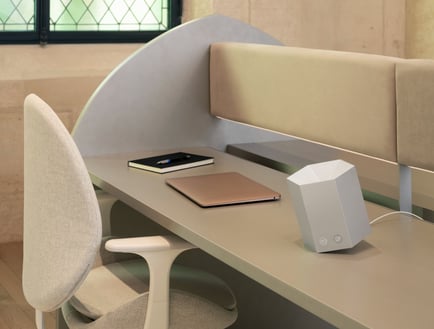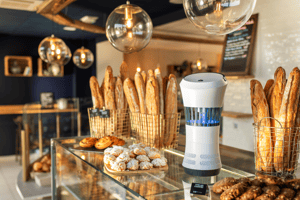Purifying the air in open plan and private offices

What good does treating the air in open plan and private offices really do?
Air purification in open plan and private offices has been shown to increase their occupants’ productivity by 8-16% thanks to breathing cleaner air that contains no chemicals. In fact, according to the French Ministry of Solidarity and Health, « superior air quality engenders an increase in productivity on the job by around 11% ».
Treating the air in these indoor spaces also reduces the cost of absenteeism related to poor air quality (€450/year/employee).
Sources: Economic, Environmental and Health Implications of Enhanced Ventilation in Office Buildings, tests conducted in 7 different cities - Study and recommendations on Green World building - Lawrence Berkeley National Laboratory - Harvard School of Public Health
The impact of viral and bacterial contamination on human health is a burden on companies, particularly those with open plan office space. As reported by the Institut Pasteur, 29% of SARS-CoV-2 infections have occurred in the workplace. The institute’s survey also noted that shared offices play a pivotal role in occupational infections.

Purifying the air guarantees an environment that is free from contamination, meaning it protects both you and your staff, whether they are working in private offices, coworking spaces, or even while telecommuting or travelling.
In the medium to long term, lowering the load of pollutants and fine particles (like PM10 and PM2.5) in the air reduces the health risks associated with overexposure to those harmful substances.
Enhanced comfort
Decreasing the social impact caused by viral and/or bacterial contamination can improve relations between employees working in open plan office spaces.
And a more comfortable work environment also involves providing allergen-free workspaces. These days, 1 in 4 employees have allergies, so purifying the air leads to less sick leave taken and a reduced need to work from home.
Similarly, enhancing the quality of life in the workplace also means managing odours like strong body odour, stale air in meeting rooms and the smell of food. A 100% improvement in cognitive function has been observed in spaces with odour-free and VOC-free air.
1- Contaminants
Especially around wintertime (October to March), there is a high risk of cross-contamination and the transmission of seasonal viruses (flu, stomach flu, airborne viruses, etc.) at offices, whether they are private or shared (open plan spaces).
2- Odours

- Strong body odour
- Food odours
- Bathroom odours
- Stale air in meeting rooms
- VOCs, O3, NOx and SOx depending on the furniture, use of an ink or laser photocopier, and cleaning products
3- Pollutants
The harmfulness of formaldehyde (an irritating, carcinogenic substance primarily used to make adhesives, binders and resins) and benzene (a carcinogenic substance with haematological effects that is produced through combustion from exhaust pipes, chimneys, cigarettes, etc.) for human health is an established fact. These pollutants are pervasive in open plan and private offices, especially in offices located in city centres.

Airborne allergens, which are often harmful to sensitive individuals, are widespread in workplaces. Whether those allergens come from dust mites or pollen, they are the source of many ailments like allergic rhinitis, mucous membrane irritation, asthma attacks, and the list goes on.
Our partner the RNSA (National Aerobiological Monitoring Network) has recorded increasingly intense spikes in allergens that are lasting longer and longer. These spikes occur between April and September, when windows tend to be left open more often.
Benefits of the Shield range
• Reduced viral load: Testing conducted by an independent lab, using the procedures defined by the standard NF B44-200 to examine the performance of Shield® in response to continuously generated contaminants. The results have shown microorganism destruction rates ranging from 94% to 97% after a single pass (whether measuring microorganisms on their own or in combinations that are representative of real atmospheres).
• Treatment of occasional odours: Testing conducted in real-world conditions, in a 40 m² room, simulating an extremely strong spike in odours and VOCs. The test results recorded a 90% decrease in odours in under 30 minutes, using both the Shield® device’s Boost mode and Continuous mode.
• Created by a master: Ramy Fischler, founder of the RF Studio agency, was named Designer of the Year in 2018 and was awarded the Order of Arts and Letters by the French Ministry of Culture and Communication in 2016.
• Dampened noise levels.
• Lasting performance and harmlessness.
• Eco-friendly: Protection for not only human health but also the environment, thanks to a design which prioritises easily recyclable materials like steel, a technology that uses no consumables and requires no filter replacements, the elimination of plastic from all packaging, and a guarantee that the device will be serviceable for at least 10 years.
• Ease of upkeep and user safety.
Key areas and times in offices
The key areas and times in open plan and private offices can all be controlled by Shield and Shield Compact professional-grade air purifiers. Here is a list of the most important ones :- Large meeting rooms, break rooms and dining rooms (Shield)
- During occasional odour-generating events (lunchtime, etc.) (Shield and Shield Compact)
- When there is a spike in contamination (sick employee) or a spike in allergens (Shield and Shield Compact)
- All private offices (Shield Compact).
Testimonial from a Corporate Executive who uses the Shield compact air purifier
“A few years ago, I learned that indoor air is more polluted than outdoor air, and I have really paid attention to that ever since. I had some experience with an air purifier when I lived in Beijing, China, and had a large unit installed in my flat. From what I understand of how it works, it seems to be just as technologically advanced. And to be honest, throughout the test period, I took it back and forth between the office and home, so I was able to use it all the time. It’s easy to forget about, because it blends into the background. It’s very quiet, but you still know you’re protected.”
M. Marc GESBERG





Laissez un commentaire